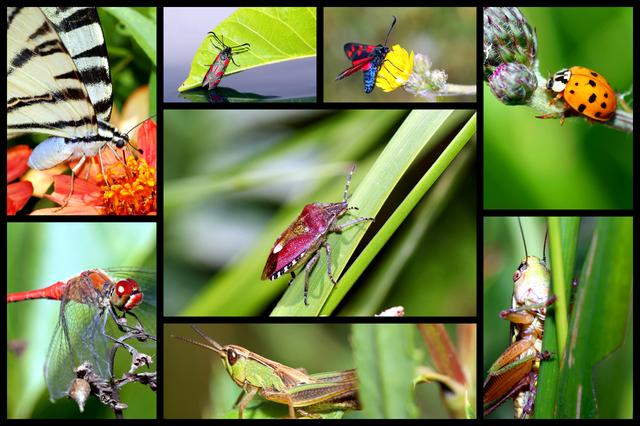Is it possible to survive in a world without insects?
Insects make up about 90% of all animal species in the world. They are also the largest group of living beings; They account for about two thirds of life on earth. Just to get an idea, if they were counted, we would have around 1,400 million insects (of about 5.5 million different species) existing for each living person. Many are still great unknowns to science. There are a million varieties already cataloged, but it is estimated that 4.5 million are yet to be discovered.
Despite their abundance, numerous studies have pointed out for years that they are the most endangered living beings on Earth. According to the Intergovernmental Scientific-normative Platform on Biological Diversity and Ecosystem Services (Ipbes), it states that based on available data, 10% of these species could be in danger of disappearing. The data is so alarming that it is said that insects are the ones that best exemplify one of the great environmental problems of this generation: the sixth mass extinction of species. “A first analysis from the University of Sydney in 2018 compiled information from various studies carried out at the regional level. The analysis concluded that 41% of species are in decline, and that a third of insects are in danger of extinction. Although they caution that the available evidence remains inconsistent, the researchers have estimated that the total biomass of insects is declining at a rate of 2.5% per year," says the Insect Atlas, a 2020 publication by Friends of the Earth International and the Heinrich Boll Foundation. “The number of missing species is devastating. As scientific evidence, in addition to published studies, one only has to visit a museum's entomological collection to realize the number of species that are not present today. In addition, on many occasions we can see, thanks to the date of capture that is reflected on the labels, how the abundance of these species decreased over time until they ended up disappearing. Another even simpler way to understand how insect populations have declined is to ask older people, especially those who used to frequent the countryside. All of them agree on how the number of individuals who could see has decreased, explains Pilar Jurado Angulo, a member of the Mario García Paris research group at the National Museum of Natural Sciences.
Of the 37 species of bumblebee that exist in the Pyrenees, nine have already disappeared. As for bees, it is estimated that of the thousand species known in Spain, 2.6% are threatened according to the Red List of European Bees. In the rest of the European continent they are not much better. Of the 2,000 species of wild bees, around 9.2% are in danger of extinction.

Annoying and very unknown, their increasing disappearance is not good news at all, neither for the planet nor for the survival of the human species. And it is that 12% of European agricultural production depends on the pollination of these species (up to 90% if we talk about fruit trees). The World Organization for Animal Health (OIE), in fact, quantifies the value they generate in the field in about 150,000 million euros A bumblebee, for example, can pollinate up to 3,800 flowers a single day.
But they are not the only ecosystem work they carry out. Insects are at the base of the food chain and serve as food for many other species. In addition, they break down organic matter, clean water resources and maintain soil fertility. «There are insects that feed on dead organic matter and, therefore, regulate the cycle of nutrients, they are also part of the diet of other organisms, control pests and conserve soils. For all these reasons, their disappearance causes great ecosystem imbalances”, says Jurado. Finally, insects help fight pests, as if it were a chemical product; some 90 species are used for biological crop protection.
Different international organizations have been pointing out the causes of these mass disappearances and the need to intervene for years. “The evolution of industrial agricultural practices has great consequences on the populations of bees and wild pollinating insects. For example, the increase in cultivated areas to pollinate intensifies the use of migratory beekeeping, which aggravates the difficulties of disease control and favors the transmission of diseases between colonies. For its part, the development of monocultures generates an impoverishment of the cultivated plant species and, therefore, of the nutrients available to the colonies. Environmental contamination, of all kinds, is also a source of intoxication for bees and weakening of colonies", they explain from the OIE.
MIGRATING L NORTH
You are free to say '𝑯𝒊!'. If I am not around, I will get back to you soon. I am a very nice @jarpad admire. It is… https://t.co/UxfFidyCVA
— 𝒱ᴀʟɪᴄʜᴏᴜ. Mon Jul 26 00:55:52 +0000 2021
In addition, we must add as causes the nitrification of the soil, introduced or invasive species as well as deforestation (the tropics have lost 1.9 million hectares in 2019, droughts or large forest fires (the fire ended that same year with more than five million hectares of forest in Australia, the Amazon and California).
Climate change has also come to add to the long list of threats suffered by these small animals. “Species have fundamentally two ways of dealing with this challenge. Either they have the ability to adapt to new conditions, or they must move to new areas that meet their climatic requirements. The problem arises when this migration is not possible, for example, because the habitat is fragmented or there is a physical barrier that they cannot cross and prevents individuals from reaching their new ideal habitat. It is easy to think that in the face of a rise in temperatures, the species would only have to change their distribution to areas of higher altitude (where the temperature is higher), however, this apparently simple ascent is not always possible since the new area may not cover the rest of the ecological needs, such as food, or that compete with species already established in that area. Faced with any of these problems, the populations of many species begin to decline until they finally disappear," Jurado warns.
The researcher even warns of the appearance of a new problem: the expansion of solar panels. A priori, “solar energy seems like a very sustainable solution, the problem comes when installations are approved without taking into account the consequences of the impacts caused on the environment. These installations also cause the loss and fragmentation of habitats. Added to this is the fact that the enormous paneled roof prevents light from reaching the ground, and with it the development of bushes or other plants on which many insects depend”, clarifies the researcher.
WE ARE ON TIME?
The OIE recalls on its website that it was in 1947 when the entity began to deal with these issues. Although the concern about the decline goes back a long way, the disappearance continues. It remains to be seen what effect public policies such as the EU's "Biodiversity Strategy" will have to address this crisis. It should be remembered that the agreement came a few days after a report on the state of nature in the EU revealed that, despite the directives, 81% of habitats and 63% of species are in a state unfavorable conservation.
“There is a great lack of entomologists who study the diversity and abundance of insects, their biology and distribution. You can't protect something you don't know. The population must also be educated to value the environment and encourage practices that respect the environment. Public policies should not favor large-scale intensive agriculture, but rather organic and traditional crops should be promoted, both limited to small plots”, says Jurado.







![47 best antiage nutritive cream in 2022 [based on 326 reviews] 47 best antiage nutritive cream in 2022 [based on 326 reviews]](https://website-google-hk.oss-cn-hongkong.aliyuncs.com/drawing/article_results_6/2022/2/27/1918fc37c66ad30564173e69d9df88a0.jpeg)
